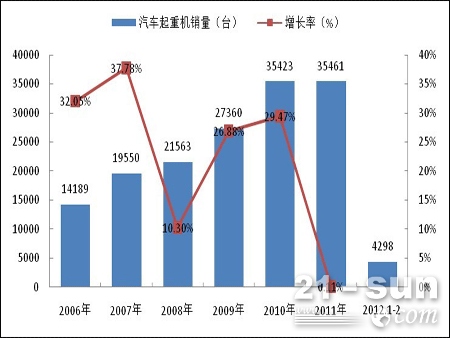February Cranes: Vehicle Lifter Drops 20%
â—† Automobile cranes warmed up, and Xugong Heavy moved exclusively to January-February 2012. A total of 4,298 truck cranes were sold, representing a year-on-year decrease of 18.98%. Among them: XCMG heavy truck cranes sold 2,406 units, a year-on-year decrease of 6.20%, and the market share decreased to 63.84%. Since the total sales volume decreased compared to the same period of last year, the brands basically all showed a declining state. Only in the north, there was a year-on-year increase in the number of traffic in Tadano and Northern China. XCMG Heavy and Zoomlion were still slightly better than their negative growth year-on-year. Industry average.

From January to February, 2012, the total sales volume and growth rate of China's truck-mounted cranes from the trend point of view, the industry concentration is further strengthened, and many second and third line brands are marginalized. At present, China’s auto crane market competition pattern is “absolutely monopolizedâ€, and Xugong’s heavy market share is further enhanced. Xugong Heavy will become an exclusive player and Zoomlion’s heavy industry will face the most severe challenges in the short term. Its market share will be affected by Sany and XCMG’s Double squeeze.
â—† Crawler cranes were separated, and Sany achieved double growth In January-February 2012, 175 crawler cranes were sold, a year-on-year decrease of 9.79%. Among them: Xugong Heavy ranked first in terms of sales volume of 48 units, and Sany Technology sold 45 units, ranking second.
Crawler crane competition is mainly concentrated in the first four companies. At present, the industry’s competitive structure is “decentralizedâ€. The main competition feature is fierce market competition. A company’s business operations may decline as long as it is slackened, and there is a high possibility of a sequential change. . In 2011, Zoomlion achieved positive growth among the top four companies, while the other three had negative growth at different levels. Zoomlion achieved double-increase growth and performed well. However, in January-February 2012, Sany achieved the most eye-catching performance and achieved double growth.
â—† With the strong car crane, XCMG moved to an exclusive position. In February 2012, 461 truck cranes were sold. Since Mudanjiang Special Gas was not included in the statistics in January, Hunan Feitao and Changchun Shenjun were newly added, so no matter whether it is year-on-year or ring-to-line. Not comparable.
In January-February 2012, the sales volume of truck-mounted cranes was 1,438 units, which was an increase of 27.26% compared with the same period of last year alone. In January of this year, Mudanjiang Specialist did not include statistics, but also increased Hunan Feitao and Changchun Shenjun, so there was no specific meaning in the year-on-year increase of 27.26, but it conveyed a signal that the truck crane was in 2012. The year will still be strong.
Japanese Restaurant Decoration
The decorations of Japanese restaurants usually include the following elements:
Harmony screen: It can be used as a partition or decoration. Wind screens are usually made of wood or bamboo, with a large amount of natural elements on the surface, such as branches and leaves, flowers and plants.
Origami art: Origami art is a traditional Japanese handicraft commonly used to decorate tabletops or walls. Common patterns in origami art include crane, turtle, and longevity characters.
Lantern: Lantern is a traditional Japanese decoration, usually made of paper or cloth, with a frame at the bottom and top to support it. In Japanese restaurants, lanterns can be hung from the ceiling, creating an elegant and warm atmosphere.
Bonsai: Bonsai is a small landscape typically composed of stones, moss, and small plants. In Japanese restaurants, bonsai is often used as a tabletop decoration to create a natural and concise atmosphere.
5. Tatami: Tatami is a traditional Japanese style floor, usually made of straw or straw mats and wood. In Japanese restaurants, tatami is often used as a floor decoration to create a comfortable and natural atmosphere.
Japanese Restaurant Decoration,Japanese Restaurant Lantern,Japanese Decorations Carp Flag,Conveyor Belt Sushi Restaurant
Guangzhou Yuyang Food Machinery Co., Ltd , https://www.yysushibelt.com